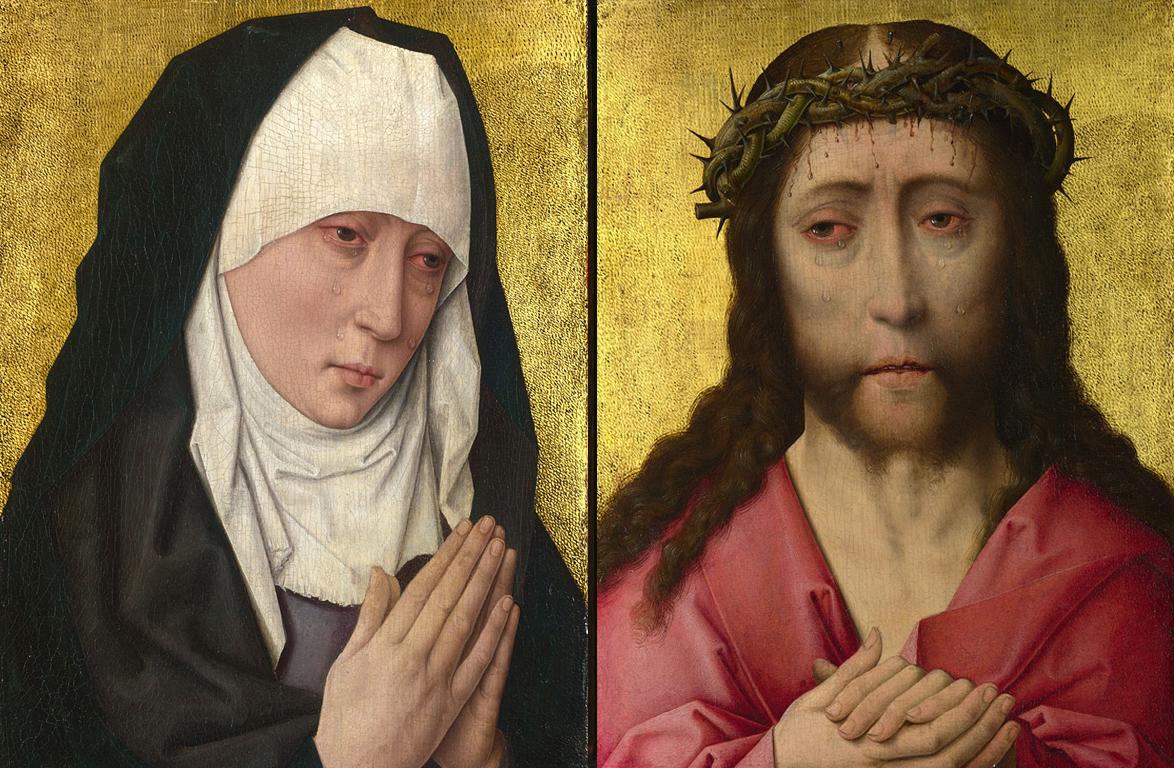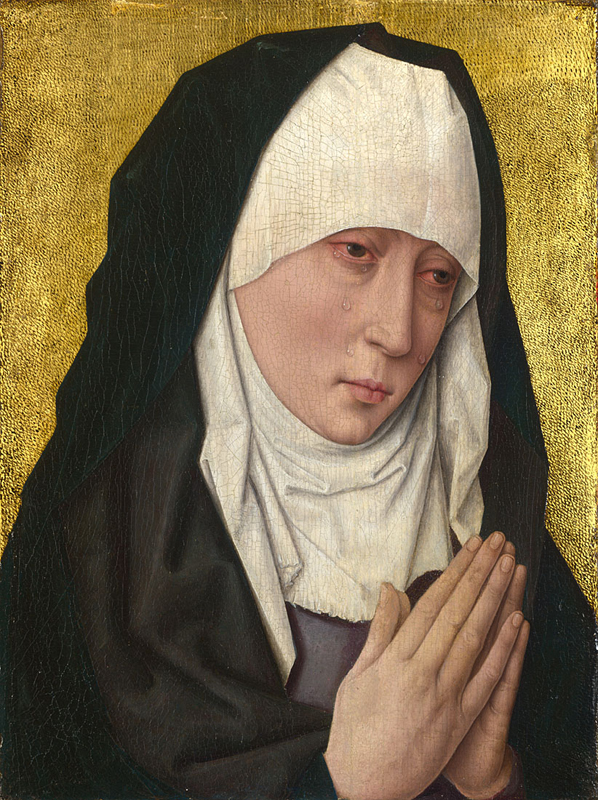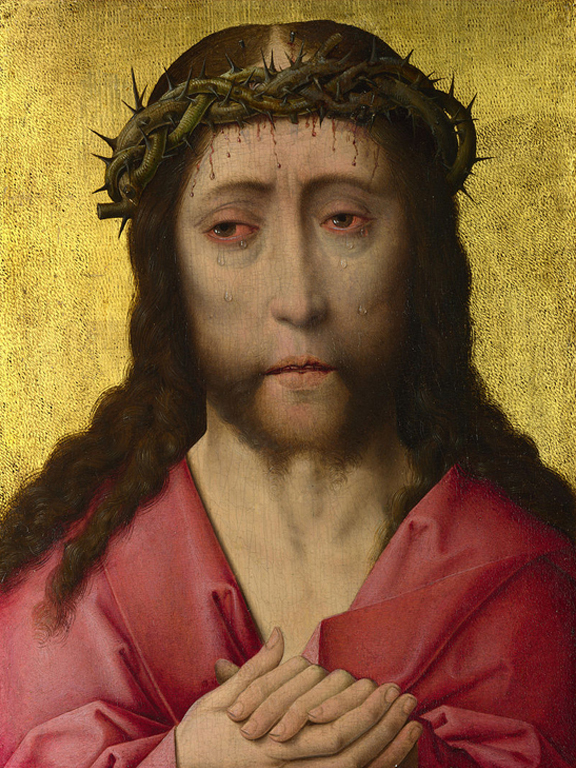March 20: Christ Transforms Death for All Time
♫ Music:
Wednesday, March 20
Christ Transforms Death for All Time
Scriptures: Isaiah 25:8, Revelation 21:4
He will swallow up death for all time, and the Lord God will wipe tears away from all faces, And he will remove the reproach of his people from all the earth; for the Lord has spoken. And he will wipe away every tear from their eyes; and there will no longer be any death; there will no longer be any mourning, or crying, or pain, the first things have passed away.
Poetry:
Not Ideas About the Thing But the Thing Itself
by Wallace Stevens
At the earliest ending of winter,
In March, a scrawny cry from outside
Seemed like a sound in his mind.
He knew that he heard it,
A bird’s cry at daylight or before,
In the early March wind.
The sun was rising at six,
No longer a battered panache above snow . . .
It would have been outside.
It was not from the vast ventriloquism
Of sleep’s faded papier mâché . . .
The sun was coming from outside.
That scrawny cry—it was
A chorister whose c preceded the choir.
It was part of the colossal sun,
Surrounded by its choral rings,
Still far away. It was like
A new knowledge of reality.
CHRIST TRANSFORMS DEATH FOR ALL TIME
In Jerusalem on the Mount of Olives stands a small chapel called in Latin Flavit Dominum, meaning: “The Lord Wept.” In Roman times mourners collected their tears in glass vials, and so atop each of the chapel’s four corners is a stone sculpture representing these vials—called in Latin lachrimatoria.
Luke tells us that when Yeshua came near this place he and “a whole crowd of his disciples” paused to take in the panoramic vista of the sacred city.
There, in the lower part of the city, sparkled the Pool of Shiloach, serving pilgrims ascending to the Temple in a state of ritual purity. Even further down the valley, lay hidden the Siloach Spring that fed the pool, where the kings of Israel and Judah were immersed prior to ascending to the throne of David. Across the valley was the magnificent Second Temple, where, in the sanctuary, there was a heavy veil through which only the High Priest could enter to offer the sacrifices for his people. Everyone knew that the presence of the Lord was not there. It had departed hundreds of years before.
And yet. He was there. The real One. Not an idea. He, a human being, a Jewish man, a Judean in the line of David. God. Even as He reigns in heaven He was present in that place. There He had taught as a boy, there where He would soon reproach the nation’s elite for bartering their ordination in exchange for worldly honor and prestige.
His followers began to joyfully praise God because they saw in Yeshua their long-expected king. Thinking that He would soon be recognized as the anointed One who would save their nation, they sang out, “Blessed is the king who comes in the name of the Lord!” “Shalom in heaven and glory in the highest!”
At this, some of the teachers protested, warning Him to rebuke them. Yeshua refused, saying: “I tell you, if they keep quiet, the very stones will cry out.” He defended their simple faith against those educated skeptics, daring to suggest that creation itself recognized Him as the only true King, the Maker of Heaven and Earth.
Startlingly, at that moment, Yeshua cried out: ‘If you only knew today what is needed for shalom! But for now it is hidden from your sight!’” (Luke 19:37-42).
A millennium earlier, King David composed Psalm 56:8 illuminating Yeshua’s grief.
Record my misery;
collect my tears in a (wine)skin— (in some translations, “bottle” for lachrimatorium, or a vial for collecting tears) are they written on your scroll?
Yeshua wept because he saw far into the future. In this present age, sin continues to cast the pall of death that blinds humanity. Isaiah foretold that this blindness will not be destroyed until the Lord of Hosts “will destroy in this mountain the face of the covering cast over all people, and the veil that is spread over all nations” on the Day of Judgement (Isaiah 25:7). Yeshua wept, knowing of the terrible judgement that is to come before He can ascend to His throne in the Millennial Kingdom.
It is Yeshua who collects the tears of the faithful in this Age, an age of sorrows, anguish, and grief. He is the vessel embodying the tears of the faithful, He the Scroll, the Word of God, the True Book of Life. Those who have repented of their sins and believed on Him throughout this Age have become the living stones that are His body, washed in His blood, set apart as holy, living pure and sacrificial lives for the sake of His name. And it is we, the living stones, who cry out to Him, “have mercy!” Our sufferings are inscribed on His body, our names inscribed on the palms of his hands (Isaiah 49:16).
Humanity’s lachrymose history does not end in the past – but in the future, when “He will swallow up death in victory; and the Lord will wipe away tears from off all faces; and the rebuke of His people shall be taken away from all the earth; for the Lord has spoken it” (Isaiah 25:8).
Prayer:
Lord, we confess that prophecy has always ever strained credulity. Embarrassed by our own enthusiasts, we bury the full wonder of scripture in a welter of theological controversy. Lord, forgive us for our unbelief. Help us to believe in in the resurrection and rapture of the saints and your soon return. In Grünewald’s portraits, we experience the full spectrum of grief and anguish that Yeshua and Miriam experienced; yet the diptych is also a stark reminder of the scandal of our faith to Jews, who regard these portraits as utterly alien. And yet, we rejoice, knowing that your return will bring exultant joy to the remnant of Israel as they look upon the crucified One and recognize You, the God of our fathers, manifest in the flesh (Thessalonians 4:15, Romans 9-11). Help us to sing with them, “Lo, this is our God, we have waited for Him!” (Isaiah 25:9) May the Church ever be a witness to you, Lord, Yeshua HaMashiach. You will be enthroned in Zion as our Kinsman-Redeemer, Lord, High Priest, and King. In the time that remains, the millennial kingdom and the New Jerusalem elude us, hovering just beyond our sight. Lord, help us to follow you, journeying with You and in You with trust borne of faith, toward the consummation of all things, steadfast and unafraid, full of thanksgiving and joy.
Judith Mendelsohn Rood, PhD
Professor of History and Middle East Studies
Biola University
For more information about the artwork, music, and poetry selected for this day, we have provided resources under the “About” tab located next to the “Devotional” tab.
About the Artwork:
Christ and the Virgin Diptych: (2 images)
Mater Dolorosa, c. 1470-1475
Christ Crowned with Thorns, c. 1470-1475
Workshop of Dieric Bouts the Elder
Oil on oak panel
36.8 x 27.9 cm (each)
The National Gallery
London, England
The Christ and the Virgin Diptych consists of two small oil on oak panel paintings. Mary is portrayed as the sorrowing Mater Dolorosa, her hands clasped in prayer as she contemplates her suffering son, Jesus Christ, portrayed in a companion painting entitled Christ Crowned with Thorns. During the period of transition between the Middle Ages and the Renaissance, the great Netherlandish painters worked to create more emotional images for personal religious devotion. The image of the mourning Virgin paired with the image of Christ crowned with thorns were an especially moving combination, as evidenced by the many extant versions of that pairing. Set against a gold background signifying a timeless, heavenly realm, the Virgin and Christ are both an embodiment of compassion and the eternal.
About the Artist:
This exceptionally fine painting of the Virgin was made in the workshop of Dieric Bouts and was probably made by his son, Dieric Bouts the Younger (1448–1491), who was a Flemish painter in the Early Netherlandish painting style. He was trained by his father, the painter Dieric Bouts the Elder (ca.1415-1475), and inherited his father’s shop in 1475. Because his painting style and that of his father are almost indistinguishable, it is difficult to attribute the paintings from the workshop with absolute certainty.
About the Music:
“Lacrimosa” from the album Various
The musical composition that sets the tone for our reflection is entitled Lacrimosa, Latin for “full of tears” or, simply, "weeping." These are the words of the Roman Catholic the Dies Irae, “The Day of Judgement” from the Requiem Mass, 18th and 19th stanzas.
Lacrimosa dies illa
Qua resurget ex favilla
Judicandus homo reus.
Huic ergo parce, Deus:
Pie Jesu Domine,
Dona eis requiem. Amen.
Full of tears will be that day
When from the ashes shall arise
The guilty man to be judged;
Therefore spare him, O God,
Merciful Lord Jesus,
Grant them eternal rest. Amen
About the Composer:
Zbigniew Preisner (b. 1955) is Poland's leading film music composer and is considered to be one of the most outstanding film composers of his generation. For many years Preisner enjoyed a close collaboration with the director Krzysztof Kieslowski and his scriptwriter Krzysztof Piesiewicz. His scores for Kieslowski's films – Dekalog, The Double Life Of Veronique, Three Colours Blue, Three Colours White, and Three Colours Red – have brought him international acclaim. Preisner has also scored many feature films including Hector Babenco's At Play In The Fields Of The Lord, Louis Malle's Damage, Luis Mandoki's When A Man Loves A Woman, Agnieszka Holland's The Secret Garden and Charles Sturridge's Fairytale: A True Story.
About the Performer:
Hanan Townshend is a New Zealand-born film composer best known for his work in director Terrence Malick’s films including The Tree of Life, Knight of Cups, and To the Wonder. Townshend was a music licensee on Terrence Malick's Palme d'Or award-winning film The Tree of Life, where he received his first significant recognition. He has also scored over a dozen commercials for brands such as Apple, American Express, Nike, and Google. Townshend’s music reflects the inspiration he finds in the poetic soundscapes of his home country, the patterns of popular music, his classical training, and art composition. He has a penchant for approaching film music from a less conventional perspective, resulting in memorable pieces that support the picturesque as much as they do the musical experience.
About the Poet:
Wallace Stevens (1879-1955) is one of America's most respected poets. Educated at Harvard and the New York Law School, he spent most of his life working as an executive for an insurance company in Hartford, Connecticut. He won the Pulitzer Prize for Poetry for Collected Poems in 1955. Known as a master stylist, he employed an extraordinary vocabulary and a rigorous precision in crafting his poetry. But he was also a philosopher of aesthetics, vigorously exploring the notion of poetry as the supreme fusion of the creative imagination and objective reality. Because of the extreme technical and thematic complexity of his work, Stevens was sometimes considered a difficult poet. But he was also acknowledged as an eminent abstractionist and a provocative thinker, and that reputation has continued since his death.
About the Devotional Writer:
Judith Mendelsohn Rood, PhD
Professor of History and Middle Eastern Studies
Department of History
Biola University
Judith Mendelsohn Rood, PhD is a Jewish Christian who taught the history of world civilizations and undergraduate and graduate seminars on Islamic Civilization, Jewish and Israeli history, and historiography at Biola University. She was drawn to teach at Biola because its founders believed that God still had a purpose and plan for the Jewish people, heroically standing up for them in their darkest hours. In an era of increasing hostility to Israel on American college campuses, Professor Rood happily served the Church by preparing disciples who are equipped to understand the grand narrative of biblical and secular history. She is now directing the academic projects of the Blackstone Center to cultivate and nurture faithful evangelical scholarship on Israel and the Middle East from a biblical perspective.


